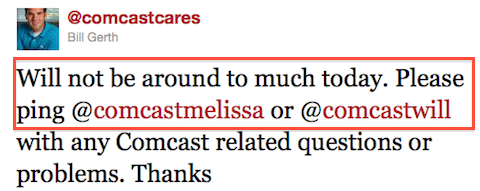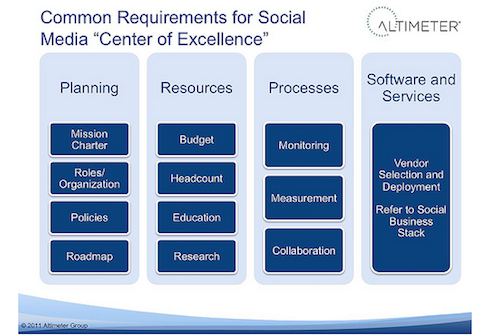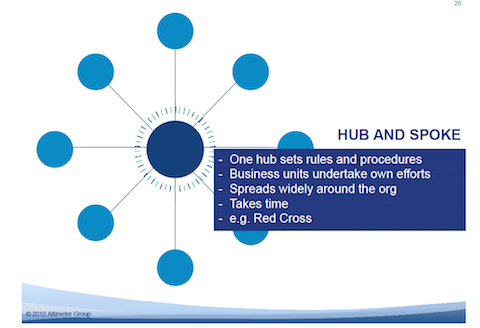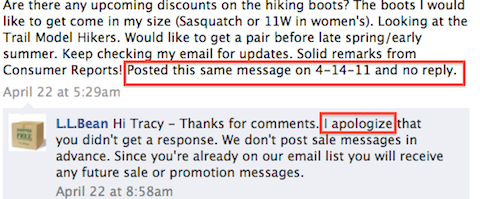 Do you need a plan to add customer service to your social strategies?
Do you need a plan to add customer service to your social strategies?
As Jeremiah Owyang states, “as internal and external demands mount, companies become mostly reactive, relegating themselves to a ‘Social Media Help Desk'.”
With strategy, planning and communication you can ensure that your company won't be caught off guard. If the day hasn't come yet when your social media team is thrust into fielding customer-service problems, it's fair to say that it's just a matter of time before they will be.
In this post, the seventh installment in the A-Z guides published here on Social Media Examiner, I'll discuss the importance of developing an integrated social media and customer relationship management program for your company.
A to Z Guide for Integrating Customer Service Into Your Social Media Strategy
#1: Allocate your resources
Assign a number of team members the responsibility of managing social networking profiles to ensure they're all covered throughout the workday.

#2: Bridge the gap
Bridge the gaps in customer-service coverage during staff breaks and vacation times. Don't risk missing important messages.
#3: Create a center of excellence
Jeremiah Owyang advocates for creating social media centers of excellence described as “a centralized program that provides resources, training and strategy to a variety of business units that are deploying social media in order to reduce costs, increase efficiency, and provide standardization. This team is often run by the corporate social strategist, who's the business stakeholder and program champion.”

#4: Deliver
Deliver on your customer communication as promised. Whole Foods, for example, lets users know what time and days they can expect to hear back.

#5: Evaluate
On a regular basis, stop and take a look to see how your social media pages are doing. Monitor reports and keywords and determine how much of your time is spent fielding customer issues.
#6: Food for thought
A couple of good mathematical equations to remember are contained in this food for thought offered by Seth Godin: “My rule of thumb is this: every person you turn away because your product or service isn't right for them turns into three great customers down the road. Every bad sale costs you five.”
#7: Guerilla marketing techniques
Ann Evanston offers five guerilla marketing techniques to improve customer experiences in the social sphere:
- Set up search phrases for issues that your target market faces, like “slow Internet” or “Internet connection.”
- Also set up search phrases for your business name. Searches are easy to set up in Twitter, MarketMeSuite, HootSuite, Social Mention and will search blog posts as well.
- Watch those mentions and respond to them! Offer empathy, help and make a suggestion. Show them you heard.
- When people use your business name positively, saying “thank you” creates a way to keep in touch as they're becoming fans and referral sources (or potential customers, if they're not already).
- If something negative happens, deal with integrity and good communication. Don't delete it; that's like putting your head in the sand. You can show others how gracious you really are.
#8: Hub and spoke
Jeremiah Owyang suggests that the hub-and-spoke model provides centralized resources to business units. And Drew McLellan recommends that clients build the web of content creation in a hub-and-spoke model. “You need to have a core—or hub—for all of your social media activity. One place that's the repository for your core content.”

#9: Interface across functions
The Community Roundtable suggests in their report, the 2010 State of Community Management, that community management is “increasingly a distinct and separate role that's explicitly responsible for interfacing across many functions to ensure continuity of care for community members.”
#10: Justification
Heed the advice of the Community Roundtable : “Measurement is NOT about justification. It's about understanding the data so that you can do a better job.”
Get World-Class Marketing Training — All Year Long!
Are you facing doubt, uncertainty, or overwhelm? The Social Media Marketing Society can help.
Each month, you’ll receive training from trusted marketing experts, covering everything from AI to organic social marketing. When you join, you’ll also get immediate access to:
- A library of 100+ marketing trainings
- A community of like-minded marketers
- Monthly online community meetups
- Relevant news and trends updates
#11: Key stakeholders
Remember, key stakeholders will care about different aspects of your social media and will need access to different types of social media metrics. In Forrester's white paper, “Social Media Marketing Metrics That Matter: Communicating the Right Data to Internal Stakeholders,” Nate Elliott points out the focus of the company's various internal stakeholders will differ. “Create frequent reporting of digital metrics to community managers and social media strategists, per-campaign or annual reporting of branding and trial metrics to other marketing team members, and quarterly or annual reporting of financial metrics to executives.”

Discover Proven Marketing Strategies and Tips
Want to go even deeper with your marketing? Check out the Social Media Marketing Podcast! Publishing weekly since 2012, the Social Media Marketing Podcast helps you navigate the constantly changing marketing jungle, with expert interviews from marketing pros.
But don’t let the name fool you. This show is about a lot more than just social media marketing. With over 600 episodes and millions of downloads each year, this show has been a trusted source for marketers for well over a decade.
#12: Listen
Set up a good listening strategy and be sure to not only listen for customers' compliments, but also keep your ears tuned to hear their complaints. Heidi Cohen says, “With the help of social media monitoring tools, customer service can hear what consumers are asking, provide timely responses, and determine early warning signs of PR and other issues.”
#13: Mitigate problems
It's one thing to listen to what customers are saying. In addition, we must also take precautionary steps and actions. As Heidi Cohen says, “In the current social media ecosystem, it's critical to have a crisis management plan in place to mitigate potential problems.”
#14: Number of interactions and issues
Some businesses are heavily focused on the number of fans and followers they're acquiring through social media. And while that's all fine and good, we must remember to track the interactions staff are having and be able to report back the issues identified and how many were successfully resolved.
#15: Opportunities
Customer-service issues and complaints need not be seen as all negative. With the right mindset, we can view them as opportunities to learn more about what people want and expect from us. Use feedback as opportunities for improvement.
#16: Processes and policies
Customer service and social media needs must be addressed by more than the marketing department. Companies are encouraged to develop thorough processes and policies. Drew Kraus writes in the Gartner paper Emerging Technology Analysis: Social CRM for Customer Service that “one of the inhibitors for the adoption of social CRM customer service technologies is the lack of defined processes and policies… Many fitting the mainstream and late-adopter profile will look to hold off on bringing the new technology into their contact centers until optimized processes and policies have been vetted by early adopters. Instead, they will opt to allow their marketing departments—which have access to near-term budget for such investments—to take the lead in handling all social CRM interactions in the interim.”
#17: Questions
Answering consumers' questions often ends up taking a back seat to responding to customer complaints. However, the timely response to a question will make customers feel heard and potentially can alleviate dissatisfaction.

#18: Resolve problems
Try to resolve problems immediately. Stacey Acevero says, “Sometimes the largest protesters can become advocates with a little bit of love and attention. If you don't provide some source of customer service or redirect online to someone who can help, you're risking your reputation.”
#19: Structural hole
A structural hole can be seen as the person between two groups who has been taken away, thereby creating a disconnect between the two groups. Community Roundtable suggests that the “recognition may cause companies to rethink the outsourcing of their Twitter accounts to their PR companies.”
#20: Template for Social CRM
Gartner's Drew Kraus offers actions for technology and service providers which includes developing a “template” social CRM for the customer-service delivery process for your customers. You may think of this as the standards by which you base all of your customer service, whereby all of your business reps deliver the same quality of care and the same services and messages.
#21: Unhappy customers
When we think about social media and customer service, there may be times when we find ourselves on the other side of the spectrum as the unhappy customer. Erik Deckers writes, “If you're unhappy with a company, by all means, complain. It's your right as a customer. But if you do it the right way, you're more likely to get what you want than if you whine and gripe about their incompetence and failures.”
#22: Variety of functions
Heidi Cohen states that social media has changed how consumers and companies view customer service. Customer service fulfills a variety of different functions including enhancing your marketing. Heidi lists 12 ways social media enhances customer service:
- Gives business a human face
- Listens to what customers are saying
- Proactively engages with prospects and customers
- Provides additional product-related content
- Answers product-related questions
- Supplies alternative contact channel
- Gives customers a channel to talk to each other
- Shares customer feedback
- Celebrates your customers
- Shows customers behind the scenes
- Makes special offers
- Creates new purchase options
#23: Wisdom
There's a lot of wisdom in this statement by Jacob Morgan from his post,
What is Social CRM? “Social CRM is about moving from fans and followers to customers and advocates.”
#24: (E)xposure
The MarketingProfs post Brands Undervalue Social Media for Customer Service points out that “when social CRM is done well, it provides the added benefits of increased exposure for your brand by helping to retain existing customers, acquiring new customers and driving brand awareness.”
#25: Why measure
For community management to be successful, we need to regularly measure our efforts. Dion Hinchcliffe writes, “If you aren't looking at overall levels of participation, growth rate of new members, making lists of the recently disengaged and following up on them, etc., then you aren't managing your social environment. Understanding the overall health and momentum in your community, directly responding to it, and doing it every day will be vital for the long-term success of your effort.”
#26: Zealous
Social CRM requires dedication and devotion. Be zealous about maintaining good customer relationships.
Have you integrated your customer service and social media efforts? What would you add to this list? Leave your comments in the box below.
Attention Agency Owners, Brand Marketers, and Consultants

Introducing the Marketing Agency Show–our newest podcast designed to explore the struggles of agency marketers.
Join show host and agency owner, Brooke Sellas, as she interviews agency marketers and digs deep into their biggest challenges. Explore topics like navigating rough economic times, leveraging AI, service diversification, client acquisition, and much more.
Just pull up your favorite podcast app, search for Marketing Agency Show and start listening. Or click the button below for more information.

